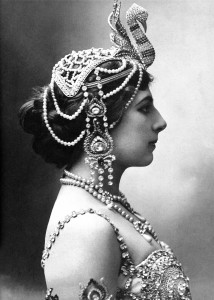
This month in Kickass Women, we’re talking about Mata Hari, infamous spy…or not. Mata Hari became a famous symbol of the dangers of a sexually liberated woman, but all she seems to have really done is have a lot of fun and some really great sex, with an unfortunately huge dollop of appropriation along the way.
Mata Hari was born Margarethe Geertruida Zelle, in Holland in 1876. Her father, a businessman, spoiled her rotten right up until he went bankrupt and abandoned the family (his wife, Margarethe’s mother, died a few days later). He married another woman and sent for his sons to come live with him but not his daughter.
M’Greet, as she was then called, went to live with her godparents, who shipped her off to boarding school. She was sent home for having some sort of scandalous relationship with the headmaster. Today, this would be a blatant case of statutory rape – she was 16 and he was 51 and in a position of institutional power over her. However, she was sent home to a new foster family, disgraced, and he remained at the school unpunished.
Later in her life, Mata Hari talked about how much she loved military men. As M’Greet, she fell madly in love with an officer, Rudolf MacLeod. They had a whirlwind courtship and got married, and she went with him to the Dutch East Indies where the Dutch army was practicing a particularly vicious form of colonialist warfare. The marriage was a disaster. Rudolf was insanely jealous (later, Mata Hari said she gave him cause to be jealous, but that seems to have come later in the marriage). He was emotionally and physically abusive towards her in private and in public. They had two children together, one of whom, Norman, died.
 The couple could not bring themselves to divorce because of money – M’Greet desperately needed access to Rudolf’s pension and he was desperate not to give it to her. Further, they fought over custody of their daughter, Nonnie. Eventually the couple separated and in 1906, their divorce was finalized. By that time M’Greet had become Mata Hari and she lost custody of Nonnie because of her risqué dances and reputation.
The couple could not bring themselves to divorce because of money – M’Greet desperately needed access to Rudolf’s pension and he was desperate not to give it to her. Further, they fought over custody of their daughter, Nonnie. Eventually the couple separated and in 1906, their divorce was finalized. By that time M’Greet had become Mata Hari and she lost custody of Nonnie because of her risqué dances and reputation.
Mata Hari moved to Paris because, as she said, “I thought all women who ran away form their husbands went to Paris.” She created a new persona for herself. Mata Hari told people that she was Lady Gresha MacLeod, the widow of a Scottish Officer. During her time as a soldier’s wife, she had studied the mysteries of Java. Her dances, she explained, were not pornographic or unseemly – they were reenactments of sacred rites, which happened to involve the removal of a lot of clothes. In a blatant display of cultural appropriation, she claimed that her dances were traditional Javanese dances. However, they were entirely her own invention, although she was influenced by the Javanese style of dance and music.
Mata Hari was not a technically trained dancer, but she was graceful, charismatic, and had a great understanding of her audience. She was able to play on the current fascination with “The Orient” and she was able to assure viewers that they were experiencing art while also presenting them with a lovely view. She was terrifically popular and very happy, as quoted in Femme Fatale, by Pat Shipman:
At this moment, I enjoy my passion for theater with full rein. More than I could ever think, I see now, that all success depends on attendant circumstances. I was pretty…and the people, the men, they love a pretty woman. They like to see as much of a pretty woman until the border of indiscreet. I have never been afraid to catch a cold, remember my décolleté, which my husband tried to forbid. Well, then, I started to use décolleté, and to use décolleté more and more. With every veil I threw off, my success rose. Pretending to consider my dances very artistic and full of character, thus praising my art, they came to see nudity, and that is still the case.
Mata Hari was all the rage for a relatively short time – her age, her weight (she was never heavy, but she was more plump than most dancers) and her reliance on novelty meant that her career shifted quickly to smaller performances. Most of her income came from her lovers. She was very candid about her sexual history and her love of men, and her lovers seem to have left quite happy. As Shipman, author of Femme Fatale, points out, Mata Hari was perfectly suited for the Belle Époque (which lasted from about 1871 – 1914) with its devotions to “Bohemian ideas, opulent art and exotic influences.”
With the outbreak of WWI, Mata Hari found herself in an increasingly patriotic and puritanical culture. Because Holland was neutral, she could still travel throughout Europe. She put on a dance contract in Berlin in 1914, just before war was declared. She went back to Holland but not before the Germans confiscated her furs and some money. At this point, things become confusing.

Mata Hari was approached by Karl Kroemer, the German consul in Amsterdam. He offered her a large amount of money if she would spy for Germany. Mata Hari took the money, and later said that, as far as she was concerned, it was money the Germans owed her anyway because they had taken her furs. She felt no obligation to deliver intelligence because she had a right to the money, and she needed it quite badly at the time. Mata Hari was always very forthright about her need to look after herself and her desire to live a luxurious lifestyle, and it would have been quite in character for her to have done some mental accounting and figure, “Ok, I’m going shopping!”

Because The Netherlands was neutral, Mata Hari was theoretically free to travel during the war. And she did, leaving a trail of happy if slightly poorer lovers behind her. The U.K. became suspicious of her and alerted France. France also asked her to spy for them, although the man who recruited her, Georges Ladoux, later insisted that he asked her to be a spy for France so that he could catch her passing secrets to Germany. Meanwhile, Mata Hari was extremely miffed that France refused to pay in advance.
Eventually Mata Hari was arrested by the French authorities on suspicion of having betrayed another agent to the Germans and on suspicion of having passed other information to them. The only evidence was some intercepted German telegrams that might not have been legitimate. There was no definitive evidence against her and she always claimed that although she had taken money from Germany she had not delivered any intelligence to them. If she was a spy, she doesn’t seem to have passed on much of value, despite France’s claim that she had caused the deaths of 50,000 people (the court did not explain how it arrived at that number).
In Femme Fatale, Tillman talks about how Mata Hari’s lifestyle and appearance were seen as evidence of guilt in a conservative court. Her interrogator, Pierre Bouchardon, was particularly disposed against her because she had “thick lips and dark skin.” He referred to her as “resembling a savage.” He was also revolted by her love life and saw her promiscuity as de facto evidence of guilt. During this time many people in Britain and France were arrested solely for being foreign, and Bouchardon stated, “We must make clear that, from our point of view, maintaining contact with the enemy is considered legally to be a crime equivalent to actually furnishing information to the enemy.”
Mata Hari was executed for espionage in 1917. Many years later, the prosecutor said of the case, “There wasn’t enough evidence to flog a cat.” In a time when many women were taking on new jobs and roles as men went to war, Mata Hari’s death served as a cautionary tale about women who might take their freedom too far.
Mata Hari is a complicated individual, to be sure. She visualized the life she wanted and she got it, if only for a short time. She was unapologetic about her performances and unafraid to seek out her own sexual pleasure. She did not have patriotic feelings towards any country, so if she did any spying, it was for money, not ideals, and she wasn’t very good at it.She was also an unashamed champion of colonialism and cultural appropriation, though at that time people weren’t addressing those issues from the same vantage point we have today. She was dishonest about some things and almost shockingly honest about others. Sometimes she seemed incredibly intelligent and shrewd, and other times she was astoundingly foolish and greedy. She loved dance, but she did not leave an artistic legacy of any kind.
Essentially, Mata Hari was a woman who refused to fit into the mold society cast her in. She was not interested in being a good student or ward or young lady or wife in any conventional sense. When her marriage went bad, she got herself out. She wanted to live “like a butterfly in the sun” and she did. She was totally unashamed of her life as a dancer and her life as the lover of many men. She totally embraced her own sexuality. She was a self-made woman who fit into a specific cultural moment perfectly, and for a while she was very happy.
My source for this column is the remarkable biography Femme Fatale: Love, Lies, and the Unknown Life of Mata Hari by Pat Shipman. While Shipman doesn’t gloss over Mata Hari’s tenuous relationship with truth, she is firmly Team Mata Hari, and after reading about all the abuse Mata Hari suffered in her marriage it’s hard not to be on her side whether she was a spy or not (Shipman thinks not). It’s certainly a biography in which the author takes sides, but it’s a fast read, it provides great insight into the mind of a confusing and inconsistent individual, and it’s well-researched – I highly recommend it.



You didn’t include her famous last words!
The story goes that she wore a trench coat to her execution by firing squad. Right before they fired, she threw the coat open, exposing herself, and declared, “Harlot, yes. Traitor, never!”
Definitely a badass. Love this series!
Sadly, that story seems to be the stuff of legend, not fact – she was very dignified on her way to her death, and blew the priest a kiss.
Oh, well. That’s also a very classy way to go.
“Matahari” means “sun” in Javanese, I learn from looking it up. I never knew her dance act was billed as Javanese. Hardly the only “oriental” entertainment act at the time.
How sad that she died so young. I love her costumes.
Thanks for that, Carrie!! I feel smarter now. But sadder too.
Yay! An article on somebody I know a little bit about! Now off to actually read it.
Wow! I knew some of the facts, like the fact that she was a dancer, but hadn’t remembered some others like her abusive marriage. There’s an early 1930’s movie on her starring Gretta Garbo in the title role. Have you seen or heard of it?